| Monreal Stones | |
|---|---|
The Monreal Stones displayed at the Baybayin section of the National Museum of Anthropology | |
| Material | limestone |
| Created | 17th century CE (inscriptions) |
| Discovered | 15 March 2011 Monreal, Ticao Island, Masbate, Philippines |
| Discovered by | Virgie Almodal |
| Present location | National Museum of the Philippines |
| Culture | Filipino |
The Monreal Stones (Filipino: Mga Batong Monreal), also referred to as the Ticao stones, are two limestone tablets that contain Baybayin characters. Found by pupils of Rizal Elementary School on Ticao Island in Monreal, Masbate, who had scraped the mud off their shoes and slippers on an irregular-shaped limestone tablet before entering their classroom, these are now housed in a section of the National Museum of Anthropology. The large, triangular stone weighs 30 kilos, is 11 centimeters thick, 54 cm. long and 44 cm. wide. The smaller stone is oval-shaped and is 6 cm. thick, 20 cm. long and 18 cm. wide.[1][2] The National Museum held a Baybayin conference to present the Monreal Stones to the public on 13 December 2013.[3]
The dating and authenticity of the stones are still under discussion,[4] however initial examination has revealed that the inscriptions could not have been made earlier than the 17th century due to the usage of the Baybayin vowel deleter introduced in 1621 by the Spanish friars.[5]
- ^ Escandor, Juan (July 3, 2014). "Muddied Stones Reveal Ancient Scripts". inquirerdotnet.
- ^ Borrinaga, Rolando O., Romancing the Ticao Stones: Preliminary Transcription, Decipherment, Translation, and Some Notes (PDF)
- ^ Bautista, Angel P. "National Museum Hosts Second Baybayin Conference". Retrieved 12 June 2019.
- ^ Guillermo, Ramon (2012). "Ang proseso ng transkripsiyon ng mga inskripsiyon sa mga Bato ng Ticao". Social Science Diliman (in Tagalog). 8 (1): 28.
Posible ring hindi kailanman matitiyak ang awtentisidad o pagpepetsa ng mga ito ayon sa kasiyahan ng lahat. Maaaring maging kapalaran nito ang katulad ng 'Calatagan Pot' na pinaliligiran ng walang katapusan at hindi maubos na tanong.
- ^ POTET, Jean-Paul G. (2019). Baybayin, the Syllabic Alphabet of the Tagalogs. Lulu.com. p. 115. ISBN 9780244142414.
but an examination reveals that they cannot be earlier than the 17th century because in the excerpt shown here, the letter nga (frames 1 and 3) has the /a/-deleter cross that Father LOPEZ introduced in 1621, and this cross is quite different from the diacritic placed under the character ya to represent the vowel /u/: /yu/ (frame 2).


